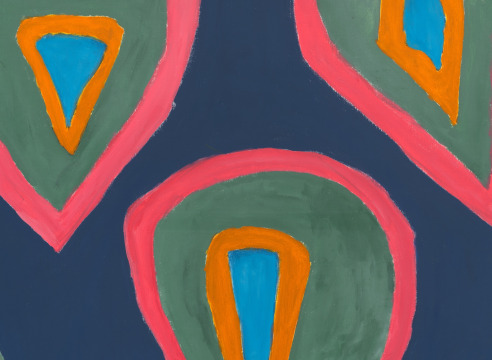
Alexander Gray Associates presented its second exhibition of works by Betty Parsons (1900–1982), Heated Sky. The paintings and works on paper from the height of Parsons’ engagement with abstraction from the 1960s to mid-1970s foreground the artist’s attunement to nature and the landscape. Parsons’ keen observation of the natural world was the ground for compositional methods ranging from loose biomorphism to geometric order, always featuring a dynamic sense of color.
Inspired by a visit to the 1913 Armory Show in New York, Parsons determined to become an artist from a young age, undertaking training in figurative sculpture and later watercolor. In 1947, one year after founding the Betty Parsons Gallery, she made her first abstract painting, thereby initiating a transformative new direction that would engage her for the next 35 years.
The completion of Parsons’ light-filled studio in Southold, NY, in 1960 ushered in a decade of work characterized by a simplification of form and color. Designed by architect and artist Tony Smith and overlooking the Long Island Sound, it fast became the artist’s regular weekend retreat and the site of concentrated art-making. In paintings such as Pasture (1963), Parsons combined a monochromatic field of color with free-floating island-like shapes in colors both analogous and complementary. Works from later in the decade introduced line-based compositions as featured in the graphic immediacy of Early Morning (1967), with its rhythmic repetition of gold and red stripes interwoven with white, black, and gray. Alongside her paintings, Parsons filled numerous sketchbooks and notebooks with spontaneous observations. Works on paper such as the red, gold, and blue Heated Sky (1976) feature highly saturated color and rhythmic brushstrokes facilitated by the fluidity of the paint.
Counting many of the period’s leading painters among her former and current gallery artists, Parsons was immersed in the languages of abstract painting. Her own work, however, was rooted in the marriage of her powers of observation and interpretation. As she described in an interview with Lawrence Alloway in 1968, “When I start a painting I try to become a blank and only let an emotion come into me. If I say, for instance, I have an idea that I want to paint an atmosphere that I see out of the window, I try to become a blank when it comes to choice of forms and colors. I go up to the canvas with a brush and suddenly decide and I pick out a gray or brown or whatever the atmosphere is and put it on very spontaneously. That color introduces an idea for another color, and I go on from there.”
The exhibition will be accompanied by a fully-illustrated catalogue, featuring a new essay by art historian Elizabeth Buhe and an introduction by Rachel Vorsanger, Collection and Research Manager for the Betty Parsons Foundation.

